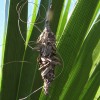 North American bagworm can feed on over 50 families of deciduous and evergreen trees and shrubs. Severe infestations can damage the aesthetics and health of host plants, especially juniper and arborvitae species. Many of the preferred host plants do not grow well below the USDA hardiness zone 8A, but due to its wide host range, high female fecundity, and method of dispersal, bagworm can still be problematic in the Florida landscape. This 5-page fact sheet was written by Brooke L. Moffis and Steven P. Arthurs, and published by the UF Department of Entomology and Nematology, March 2013.
North American bagworm can feed on over 50 families of deciduous and evergreen trees and shrubs. Severe infestations can damage the aesthetics and health of host plants, especially juniper and arborvitae species. Many of the preferred host plants do not grow well below the USDA hardiness zone 8A, but due to its wide host range, high female fecundity, and method of dispersal, bagworm can still be problematic in the Florida landscape. This 5-page fact sheet was written by Brooke L. Moffis and Steven P. Arthurs, and published by the UF Department of Entomology and Nematology, March 2013.
http://edis.ifas.ufl.edu/in981
Tag: Urban Tree Pest Insects
Emerald Ash Borer: A Potential Future Threat to Ash Trees in Florida (FOR284/FR346)
 Do not move firewood into or around the state! This invasive exotic beetle kills ash trees and is likely to reach Florida in the years to come — or faster if it gets transported by humans. Learn more in this 5-page fact sheet was written by Don Spence and Jason Smith, and published by the UF Department of School of Forest Resources and Conservation, August 2011.
Do not move firewood into or around the state! This invasive exotic beetle kills ash trees and is likely to reach Florida in the years to come — or faster if it gets transported by humans. Learn more in this 5-page fact sheet was written by Don Spence and Jason Smith, and published by the UF Department of School of Forest Resources and Conservation, August 2011.
http://edis.ifas.ufl.edu/fr346
Granulate Ambrosia Beetle, Xylosandrus crassiusculus (Motschulsky) (Insecta: Coleoptera: Curculionidae: Scolytinae) (EENY131/IN288)
The granulate ambrosia beetle is a minute ambrosia beetle of Asian origin that was first detected near Charleston, South Carolina. It can become abundant in urban, agricultural, and forested areas and has been reported as a pest of nursery stock and young trees in the Old World tropics and of peach trees in South Carolina. It is a potentially serious pest of ornamentals and fruit trees and is reported to be able to infest most trees and some shrubs (azalea), except for conifers. Learn more in this revised 4-page fact sheet was written by Thomas. H. Atkinson, John L. Foltz, Robert C. Wilkinson, and Russell F. Mizell, and published by the UF Department of Entomology and Nematology, March 2011.
http://edis.ifas.ufl.edu/in288
Fall webworm, Hyphantria cunea (Drury) (Insecta: Lepidoptera: Arctiidae: Arctiinae) (EENY486/IN878)
This 9-page illustrated fact sheet describes this pest whose larvae form large tents in the foliage of many ornamental trees & shrubs, and also agronomic crops — synonymy, distribution, description and life cycle, hosts, economic importance, and management. Includes references. Written by Andrei Sourakov and Thomson Paris, Published by the UF Department of Entomology and Nematology as part of the Featured Creatures collection, December 2010.
http://edis.ifas.ufl.edu/in878